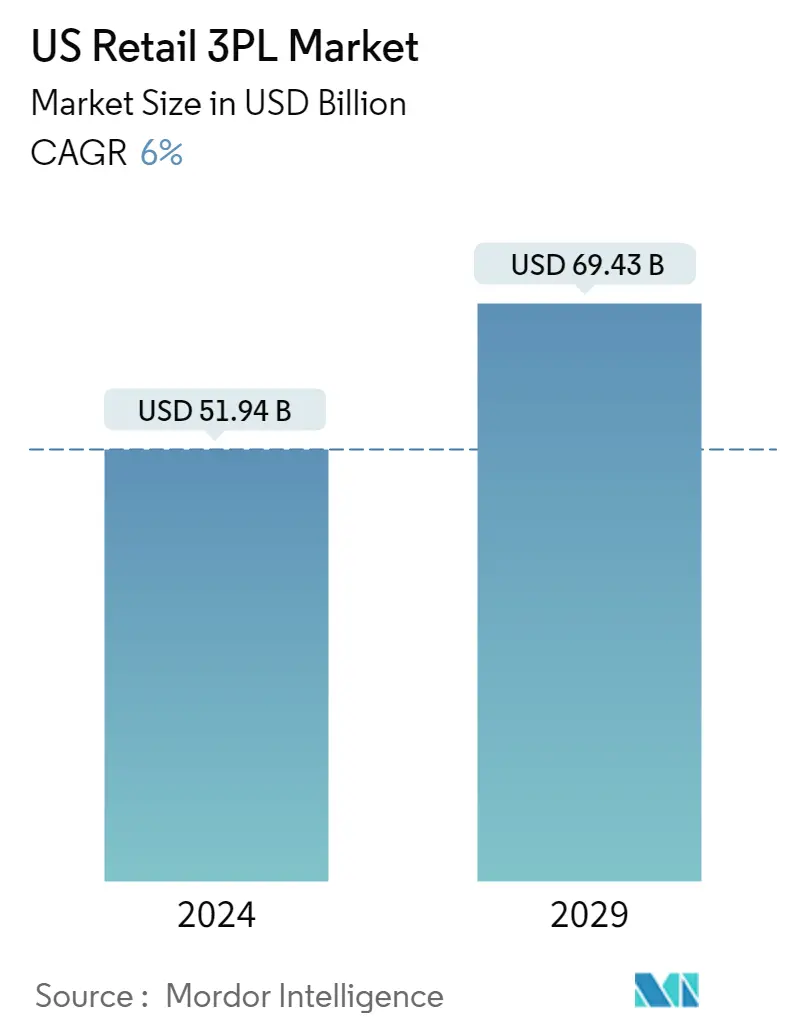Market Size of US Retail 3PL Industry

| Study Period | 2020 - 2029 |
| Base Year For Estimation | 2023 |
| Forecast Data Period | 2024 - 2029 |
| Market Size (2024) | USD 51.94 Billion |
| Market Size (2029) | USD 69.43 Billion |
| CAGR (2024 - 2029) | 6.00 % |
Major Players
*Disclaimer: Major Players sorted in no particular order |
US Retail 3PL Market Analysis
The US Retail 3PL Market size is estimated at USD 51.94 billion in 2024, and is expected to reach USD 69.43 billion by 2029, growing at a CAGR of 6% during the forecast period (2024-2029).
- From USD 3.78 trillion in 2019, total retail sales climbed 6.9% to USD 4.04 trillion in 2020. Given the negative impact of the coronavirus epidemic on in-store buying, the significant increase in total retail sales may come as a surprise. However, digital sales accounted for the majority of retail growth. In 2020, e-commerce accounted for over three-quarters of all retail growth (74.6 percent), the greatest share of overall growth the online sector has ever had. Offline sales, which include stores, catalogs, and call centers, grew 2.1% in 2020, which was the same rate as the pandemic-free prior year.
- Meanwhile, in April 2023, the United States retail sales witnessed growth on both a month-over-month and year-over-year basis. However, clothing and clothing accessory stores continued to face challenges, with a 0.3% drop in sales compared to the previous month and a 4.1% decrease compared to the same period last year. The overall retail sales growth is majorly driven by resilient consumer spending despite the inflation fluctuation. In addition, moderate price levels, continued labor market strength, and wage gains have increased consumers’ ability to spend.
- Despite the increasing consumer spending, clothing and apparel sales have slightly declined, as consumers are becoming more aware of the quality of the products. Whereas, in 2022, according to the Specialty Food Association (SFA) study, specialty foods and beverage sales witnessed significant sales by more than 9.3%. The specialty market is composed of 63 food and beverage categories which combined account for nearly 22% of retail food and beverage sales. Thus, the growing retail sales are expected to create a huge demand for third-party logistics networks in the country.
US Retail 3PL Industry Segmentation
Third-party logistics, often known as 3PL, is a system in which a company offers inventory management and delivery services to another company. A 3PL company is frequently used by a company (client) that does not have its own logistics department. In turn, the 3PL takes care of some or all of the client's logistics needs. Furthermore, a comprehensive background analysis of the United States Retail 3PL Market covering the current market trends, restraints, technological updates, and detailed information on various segments and the competitive landscape of the industry. The impact of COVID-19 has also been incorporated and considered during the study.
United States retail 3PL market is segmented by product (food and beverages, personal and household care, apparel, footwear, and accessories, furniture, toys, and hobby, electronic and household appliances, and other products), by distribution channel supermarkets/hypermarkets, convenience stores, and department stores, specialty stores, online, other distribution channels). The report offers market size and forecasts for the United States retail 3PL market in value (USD) for all the above segments.
| By Product | |
| Food and Beverages | |
| Personal and Household Care | |
| Apparel, Footwear, and Accessories | |
| Furniture, Toys, and Hobby | |
| Electronic and Household Appliances | |
| Other Products |
| By Distribution Channel | |
| Supermarkets/Hypermarkets, Convenience Stores, and Department Stores | |
| Specialty Stores | |
| Online | |
| Other Distribution Channels |
US Retail 3PL Market Size Summary
The US Retail 3PL market is poised for significant growth, driven by the increasing shift towards e-commerce and the evolving consumer shopping patterns. The market is characterized by a mix of global and local players, with major companies like FedEx, UPS, and XPO Logistics playing pivotal roles. The retail services industry in the United States benefits from well-established distribution channels, fostering a competitive environment that encourages innovation and efficiency. The rise in e-commerce sales, particularly in categories like clothing and general merchandise, underscores the growing demand for third-party logistics services. This demand is further amplified by the robust retail sales and consumer spending, which have shown resilience despite economic challenges such as inflation.
The market landscape is dynamic, with strategic acquisitions enhancing the capabilities and reach of key players. For instance, the acquisition of U.S. Xpress by Knight-Swift Transportation Holdings Inc. and the expansion efforts by DSV through the acquisition of S&M Moving Systems West and Global Diversity Logistics highlight the ongoing consolidation and growth strategies within the sector. These developments are indicative of the market's fragmented nature, where both global and local entities strive to capture a larger share of the burgeoning retail logistics market. As the retail sector continues to evolve, the role of third-party logistics providers becomes increasingly critical in ensuring efficient and timely delivery of goods, thereby supporting the overall growth trajectory of the US Retail 3PL market.
US Retail 3PL Market Size - Table of Contents
-
1. Market Dynamics And Insights
-
1.1 Current Market Scenario
-
1.2 Market Dynamics
-
1.2.1 Drivers
-
1.2.1.1 Increasing E-commerce Sales
-
-
1.2.2 Restraints
-
1.2.2.1 Drivers Availability
-
-
1.2.3 Opportunities
-
1.2.3.1 Digitalizing the Supply Chain Network
-
-
-
1.3 Value Chain / Supply Chain Analysis
-
1.4 Industry Policies and Regulations
-
1.5 General Trends in Warehousing Market
-
1.6 Demand From Other Segments, such as CEP, Last Mile Delivery, Cold Chain Logistics Etc.
-
1.7 Insights on Ecommerce Business
-
1.8 Technological Developments in the Logistics Sector
-
1.9 Industry Attractiveness - Porter's Five Forces Analysis
-
1.9.1 Bargaining Power of Suppliers
-
1.9.2 Bargaining Power of Consumers
-
1.9.3 Threat of New Entrants
-
1.9.4 Threat of Substitutes
-
1.9.5 Intensity of Competitive Rivalry
-
-
1.10 Impact of COVID-19 on the Market
-
-
2. Market Segmentation
-
2.1 By Product
-
2.1.1 Food and Beverages
-
2.1.2 Personal and Household Care
-
2.1.3 Apparel, Footwear, and Accessories
-
2.1.4 Furniture, Toys, and Hobby
-
2.1.5 Electronic and Household Appliances
-
2.1.6 Other Products
-
-
2.2 By Distribution Channel
-
2.2.1 Supermarkets/Hypermarkets, Convenience Stores, and Department Stores
-
2.2.2 Specialty Stores
-
2.2.3 Online
-
2.2.4 Other Distribution Channels
-
-
US Retail 3PL Market Size FAQs
How big is the US Retail 3PL Market?
The US Retail 3PL Market size is expected to reach USD 51.94 billion in 2024 and grow at a CAGR of 6% to reach USD 69.43 billion by 2029.
What is the current US Retail 3PL Market size?
In 2024, the US Retail 3PL Market size is expected to reach USD 51.94 billion.

